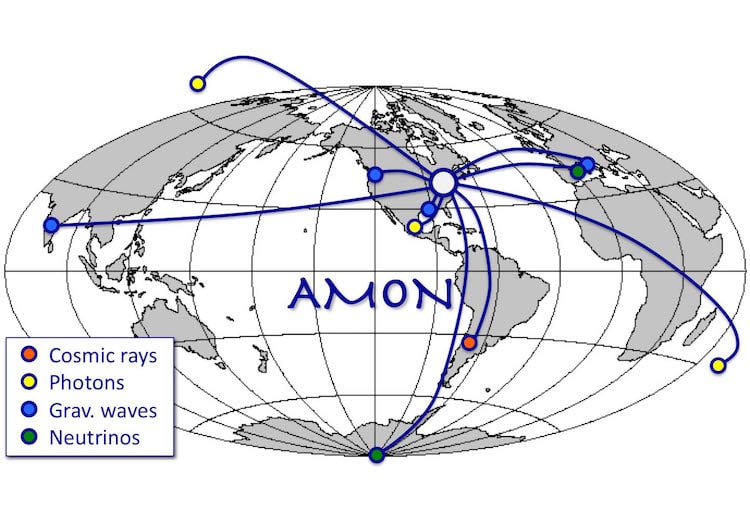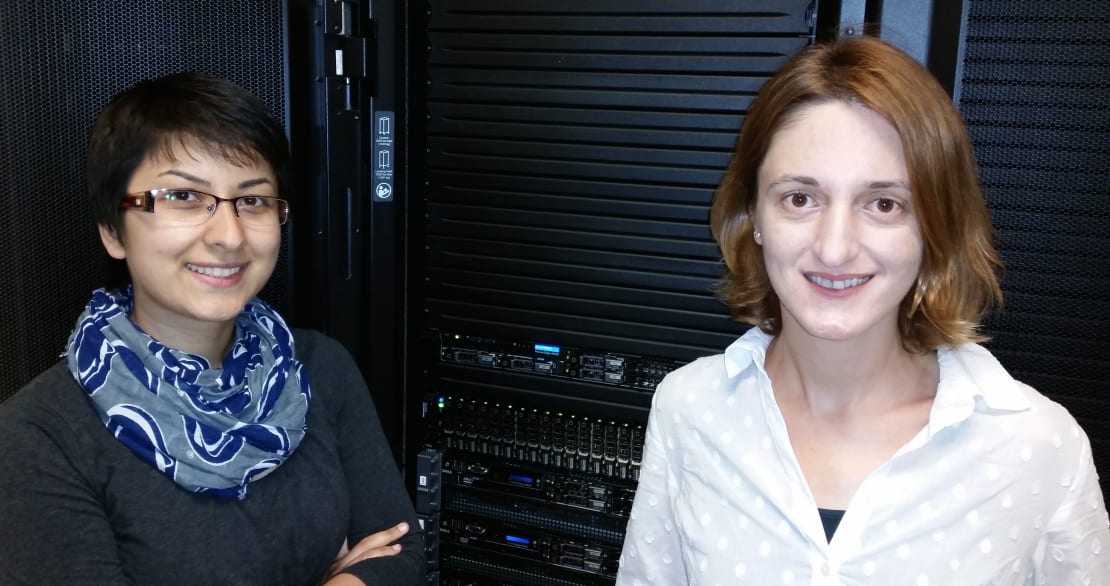The realization of multimessenger astrophysics will open up a new field of exploration of the most violent phenomena in the universe. Today, messenger particles of all four of nature’s fundamental forces reach detectors on the ground and satellites in space. Finding coincident signals from these experiments in real time will give us tremendous leverage in the hunt for their sources. The Astrophysical Multimessenger Observatory Network (AMON)* will link existing and future high-energy astrophysical observatories into a single virtual system, enabling near real-time coincidence searches for multimessenger astrophysical transients and their electromagnetic counterparts and providing alerts to follow-up observatories.
AMON member observatories, those that have signed the AMON Memorandum of Understanding (MoU), include the IceCube and ANTARES neutrino observatories, the HAWC and VERITAS gamma-ray observatories, the Pierre Auger Cosmic Ray Observatory, the Swift satellite, the FACT telescope, and the MASTER robotic telescope network. The Advanced LIGO gravitational wave detector, the Fermi LAT orbital telescope, and the Palomar Transient Factory have signed the AMON Letter of Collaboration (LoC), an intermediate step towards the MoU.

IceCube plays a key role in AMON multimessenger searches by providing high-quality neutrino data over a wide range of energies. There are two neutrino streams from IceCube that are transmitted to AMON in real time: the muon neutrino singlet stream and the high-energy starting event (HESE) stream.
The muon neutrino singlet stream contains mostly data from atmospheric neutrino events. The data are distilled down to a few important quantities, such as direction, arrival time, and energy. These events, about 10 per hour, will first reach the IceCube main data center in Madison, through the standard satellite data transfer from the South Pole. Then, they will immediately be copied to AMON servers at Penn State. These events alone, which are dominated by neutrinos from cosmic-ray showers, cannot be used to make a statistically significant discovery of an astrophysical source. However, if one or more of these events are found in temporal and spatial coincidence with an event from another multimessenger data stream, together they could lead to the discovery of an otherwise hidden astrophysical source. If such coincidences are detected, AMON will distribute alerts in real time for follow-up observations via the Gamma-ray Coordinates Network (GCN).
AMON also receives the HESE stream, which is IceCube’s most signal-rich data used in searches for astrophysical sources. But the stream also contains a significant amount of atmospheric high-energy neutrino events. After being transmitted to AMON, the “signal” events from the HESE stream, defined as those with energies above a certain threshold, will be sent immediately for follow-up observations via GCN. The remaining HESE events will be used in the standard AMON coincidence analyses.
Additionally, there are ongoing efforts with other collaborators (e.g., from the Pierre Auger and HAWC collaborations) to get their subthreshold data streams in real time to AMON.
The analyses performed so far include archival searches for jointly emitting neutrino + gamma-ray data (IC40/59 + Fermi LAT) and coincidence analysis of neutrino (IceCube),
gamma-ray (HAWC), and cosmic-ray data (Pierre Auger), which aim to detect a distinctive primordial black hole (PBH) evaporation signature. The archival searches currently underway include coincidence analyses between Pierre Auger data and public IceCube data, Swift gamma-ray and public IceCube data, and Swift gamma-ray and public LIGO gravitational wave triggers. All these types of analyses are planned to be conducted in real time. Plans are also being considered to extend the neutrino + gamma-ray searches using private IceCube data (IC79/86 + Fermi LAT) in collaboration with IceCube members.

In May 2015, AMON established a connection with GCN**, an important milestone toward real-time alert distribution. Initially, AMON alert streams at GCN will be established as private streams, available only to collaborating AMON experiments. In the future, any of these streams can be made public with the approval of the participating observatories. For example, IceCube has decided to make HESE neutrinos public, so the AMON stream at GCN broadcasting the HESE alerts will be open for public as well.
Currently, AMON is deploying two new high-availability (less than one hour of downtime per year) servers, which are physically and cybersecure and have memory mirroring and power redundancy. Each server is hosted in a separate secured data center on the Penn State campus. This system is administered by the Institute for CyberScience at Penn State. The new servers will be ready as early as September 2015 to start issuing real-time alerts via GCN to the AMON collaborators and follow-up facilities.
** Thanks to Scott Barthelmy, the principal investigator of GCN, who made this connection possible.